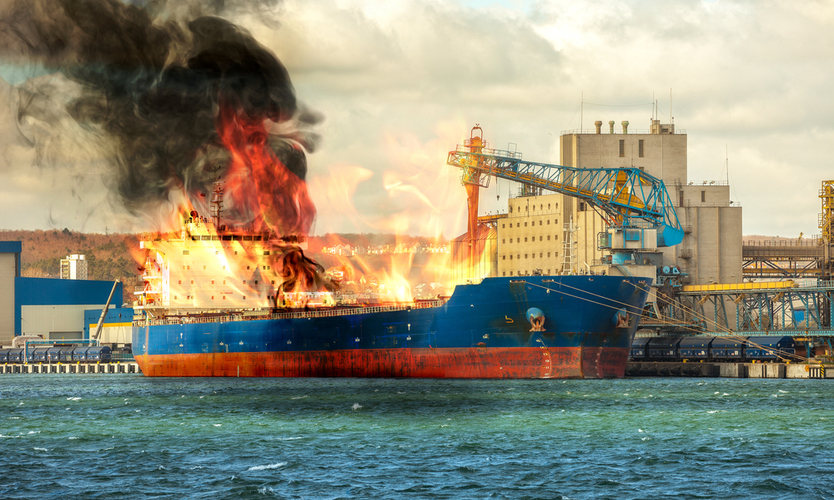The chocked-up marine supply chain, as illustrated by news photos of ships sitting at ports for long periods waiting to be unloaded, is becoming an issue of increasing concern to the insurance industry.
While delays in unloading cargos are not necessarily covered in insurance policies — assuming they don’t involve the spoilage of perishable foods or pharmaceuticals — there is cumulative risk as ships line up to unload in Long Beach, California, the busiest container port in the western hemisphere for the past 20 years, and other major ports in the United States and globally, experts say.
This can come from a catastrophe such as a storm, as was the case with 2012’s Superstorm Sandy; an earthquake that damages port facilities; or a fire (see related story below).
Experts say marine supply chain risks are complex and encompass not just the ships but shipping containers, warehouses, trucking and rail facilities, and labor, all of which are in short supply.
The Suez Canal blockage by the Evergreen container ship in March illustrated the supply chain’s fragility and its vulnerability to chokepoints, they say.
Observers generally attribute the crisis to the pandemic, as stuck-at-home consumers ordered many more goods than usual.
They say the logjam is also the unintended consequence of the focus on just-in-time inventory, a strategy in which companies maintain low inventories and receive goods as close as possible to when they are needed, which left them unprepared for the pandemic-created surge in orders.
The pandemic threw the supply chain “totally out of sync globally,” said John Kartsonas, managing partner at Breakwave Advisors in New York.
“Insurers are insuring goods in transit, and they don’t like it when goods are stationary, because there’s an aggregation of risk,” as ships pile up outside ports, said Lars Gustafson, Sayville, New York-based managing director, U.S. marine practice, for Arthur J. Gallagher & Co.
Backlogged ships represent “a significant exposure, and it’s something we don’t have quantified to anybody’s comfort level,” said Sean Dalton, New York-based head of marine for North America for Munich Re America.
Exacerbating the issue is that relatively few ports are designed to accommodate huge container ships. For example, large container ships stranded in Long Beach cannot go up the coast to Oakland, because the cranes there cannot reach the cargo on them, said Andrew Kinsey, Patchogue, New York-based senior marine risk consultant for Allianz SE.
The port at Ensenada, Mexico, about 90 miles south of San Diego, is properly equipped but is unaccustomed to handling large volumes, and there is concern about the risk of theft in transporting cargo from the country, said Richard Lawson, Dallas-based assistant vice president of risk engineering for Zurich North America.
The shortage of containers is also an issue. The few container manufacturers have increased output but are “not keeping pace with demand,” and there is a 14-day waiting period for empty containers, said Andrew D’Alessio, New York-based head of ocean cargo, Americas, for Axa XL, a unit of Axa SA.
There is potential liability from either using containers on ships not designed to handle them or from transporting cargo normally carried in containers by other means, such as open holds, where cargo can topple, and potentially put the goods, ship and crew at risk.
Observers say theft is an issue when cargo is stored in unsecured port sites because of the shortage of warehouse space. Cargo at rest is more susceptible to theft, said William Markham, San Francisco-based assistant vice president for ocean marine, in charge of cargo for Travelers Cos. Inc.
Other issues include a shortage of trucks, aging drivers, and a deteriorating road structure to move the unloaded cargo, Mr. Kinsey said.
Inexperienced, overworked truck drivers are “a recipe for disaster,” said Alex Rosas, Fort Lauderdale, Florida-based president of Amwins Specialty Logistics Underwriters.
Some companies are chartering their own vessels to get around the bottlenecks, but experts say this comprises only a small percentage of the total cargo awaiting delivery, and the ships may also have to wait in line to offload their cargos.
The jam of container ships at major ports has not affected the already hard marine insurance market so far, experts say.
“I don’t think it’s had much of an impact on the insurance market yet, primarily because the marine market doesn’t insure pure delays,” said Charles McCammon, director, claims management, marine, for Willis Towers Watson PLC in Philadelphia.
But there could be an effect if those purchasing marine cargo insurance do not know how much of an accumulation of risk they have in a particular place, Mr. McCammon said. “Insurance markets get very uncomfortable with a lot of risk at one spot,” he said.
Right now, the market is stable, but if there is a major loss or disaster, such as the 2015 explosions in the port of Tianjin, China, “the amount of loss is going to be significant, and it’s going to drive up costs easily,” said John Frazee, Los Angeles based senior vice president, specialty marine, for Marsh LLC.




